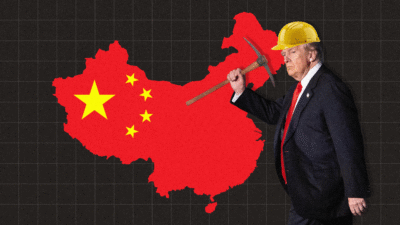US Service Economy Suffers Unexpected Trade War Blow
The surprising news comes just ahead of an all-important jobs report from the Labor Department due out Friday.

Sign up for smart news, insights, and analysis on the biggest financial stories of the day.
Don’t look now, but another economic indicator is blinking red.
New data from the Institute for Supply Management (ISM) on Wednesday showed that the US services sector unexpectedly contracted in May, bucking a nearly year-long trend. The surprising news comes just ahead of an all-important jobs report from the Labor Department due out Friday.
At Your Service
While much has been made of the decades-long decline of US manufacturing amid this year’s trade war, much less attention has been paid to the US services sector, which ran a $293 billion surplus in 2024. Now, it appears that trying to boost the former may be coming at the expense of the latter. The ISM’s purchasing managers’ index for service providers fell 1.7 points to 49.9 in May (anything below 50 signals a contraction). That’s the first contraction since June 2024 and only the fourth reading below 50 since June 2020.
Why? Tariffs and economic uncertainty. Still, not every service sector has been hit equally:
- Among the 10 services sectors that actually grew in May, per the ISM, was accommodation and food services, perhaps surprising given the other red flags recently raised by the industry. On the flip side, eight industries reported a contraction in May, after just seven in April; those sectors include retail trade, finance and insurance, transportation and warehousing, and construction.
- “Tariff variability has thrown residential construction supply chains into chaos,” one survey respondent in the industry told the ISM. “Many items are still manufactured in southeast Asia, and suppliers are beginning to test the waters for increases. Major heating, ventilation, and air conditioning equipment manufacturers are passing on their cost increases due to higher refrigerant and steel commodity prices.”
Inflation Strikes Back: Numbers under the hood are cause for even more concern. The survey’s price index increased near levels not seen since November 2022, when headline inflation numbers ran around 7%. On the flip side, services employment figures looked rosy by comparison — increasing 1.7% since April. A separate report from ADP Research on Wednesday, however, showed private-sector hiring cooling to its slowest pace in two years in May. “We’re not getting the warm fuzzies [about Friday’s jobs report] given what has been seen so far,” Jennifer Lee, senior economist at BMO Capital Markets, told MarketWatch Wednesday. That, of course, puts the Fed in a tough spot heading into the monetary policy committee’s next meeting on June 17: The economy is contracting, the labor market could be softening, and inflation may be back on the rise. Complicating matters further? The Wall Street Journal reported on Wednesday that economists are growing skeptical about the quality of inflation data from the suddenly short-staffed Bureau of Labor Statistics, which hasn’t cast as wide a survey net as it typically does.











